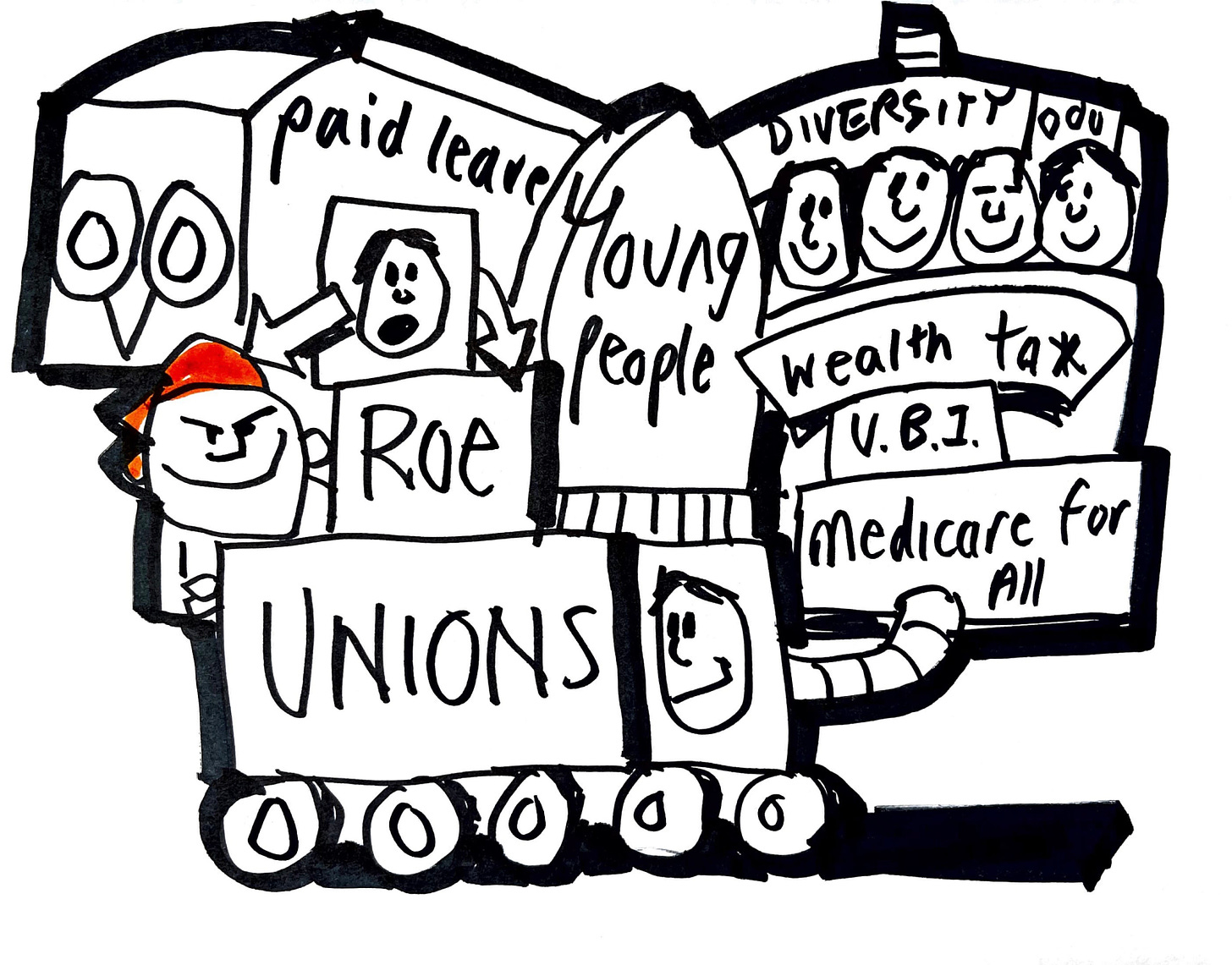In a comment on this past Saturday’s post, Paula OH said: “It’s a very tough time. We need a hope machine! Anyone know how to build one?”
My answer to Paula is a resounding: “yes!” And in a moment I’ll give Paula and you some hammers, nails, and solar panels to build one.
First, though, I want to validate your discouragement.
We expected COVID to be gone by now. We thought the minimum wage would be raised by now, that bold measures to slow climate change would be enacted by now, that pharmaceuticals would be cheaper and childcare widely available by now. We never thought we’d be back in a Cold War with Russia, that racist “replacement” theory would lead to a massacre by a crazed gunman, that Trump would be back stirring up nationalist racism, that a single Democratic senator named Joe Manchin would destroy a progressive agenda most Americans favor, that inflation would rip through the economy, or that Roe v. Wade would be repealed. And now we face the serious possibility that the next Congress will be under the control of crazy right-wingers.
Don’t kick yourself for feeling lousy. You have every right to feel that way.
But let me say something else as clearly as I can. I’ve been at this fight a very long time, and right now I find lots of reasons for hope. Ten, to be exact. (Here’s where the hammers, nails, and solar panels for Paula’s hope machine come in.)
1. First, unions are stronger today — and more workers want to join a union — than at any time in the last four decades. Between October 1, 2021 and March 30, 2022, the National Labor Relations Board recorded a 57 percent increase in workers filing for the petitions to allow union elections. That’s a good thing. Unions give workers a voice. They lead to higher wages and better working conditions.
2. A second reason for hope: Many issues now on table — with serious odds of being enacted within the next five or six years — would have seemed leftwing fantasies a decade ago. We haven’t achieved them yet, but most Americans have come around to supporting them. A majority is in favor of Medicare for All. There’s also a surge of support for Universal Basic Income. Also for free public higher education. And for a wealth tax on billionaires.
3. The more America sees of Trump, the more most people are reminded of how disastrous he was for the nation and why we need stable and thoughtful individuals in positions of power. If Trump gets back on Twitter, his divisive and racist drivel will be harmful, of course. But it will also pull many Democrats, Independents and young people back into the fight against Trumpist racist nationalism. Ditto for all the Trump wannabes who have been advancing in Republican primaries.
4. The Supreme Court’s conservative majority is a horror show — but it’s also another reminder to most people of why we need a Democrat in the Oval Office and a Democratic senate. The imminent reversal of Roe is galvanizing a new and even stronger wave of activism.
5. The young people I teach and work with are some of the most committed, talented, and progressive people I’ve ever had the privilege of teaching and working with. I’m not talking only about Berkeley, or even the coasts. I’m finding such young people across America. Many are entering politics. AOC is the leading edge of a generational wave that is transforming American politics for the common good.
6. Speaking of waves: Tucker Carlson may bemoan it, and his older and whiter Fox News viewers may hate it, but the demographic forces now reshaping America cannot and will not be reversed. We’re a more diverse society than ever before. This diversity will be a huge strength in the future. And it will be an additional bulwark against racist nationalism.
7. The myth of the decline of the West and the rise of the East — propounded by China and Russia — is proving itself bankrupt. Putin’s war on Ukraine is showing the world that totalitarian systems can’t even execute a war efficiently. Because dissent is stifled, accurate information doesn’t get back to headquarters. Because oligarchs have ravaged government funds, weapons systems don’t work. Because hierarchies are rigid and education in short supply, armies lack the training they need. Putin’s war is also revealing how fragile the Russian economy is, as is any economy whose strength turns on raw materials.
8. But the pandemic has revealed the unnecessary harshness of American capitalism. The horror of COVID has built public support for paid family leave, universal childcare, and universal access to healthcare. The pandemic has also shown us how essential our “essential” workers really are — fueling measures to raise state minimum wages (even if the federal minimum lags behind).
9. At the local and community level, the pandemic has shown most Americans just how kind we can be to one another, how much we depend on each other, and — as Tocqueville noted almost 180 years ago — how rich this nation continues to be in grass-roots voluntary efforts for the common good. Take a day off from the grim national and international news to walk around your town, and you’ll see what I’m talking about.
10. Finally, let me remind you this is a long game. Fifty years ago, a person could be imprisoned for being gay, there was virtually no Black middle class, women were second-class citizens, no women headed large corporations or sat on the Supreme Court. Fifty years ago, tens of thousands of Americans and Vietnamese were dying in a purposeless war, the Democratic Party was under thumb of big city bosses, Los Angeles was buried under smog, we suffered a crime wave far larger (in proportion to our population) than anything seen today, poverty was deeper, and Richard Nixon was unleashing his “plumbers” to break into the Watergate headquarters of the Democratic National Committee.
The struggle never ends. It is hard because it has to be hard — because the fight is about overcoming fundamental imbalances of power, and those with power will not give it up without a fight. Martin Luther King Jr., was almost correct when he reminded us that “the arc of the moral universe is long, but it bends toward justice.” He would have been more accurate had he also reminded us that there are bumps and potholes in that arc, some of which send us into temporary tailspins.
What do you think? Where do you find hope these days?














Share this post